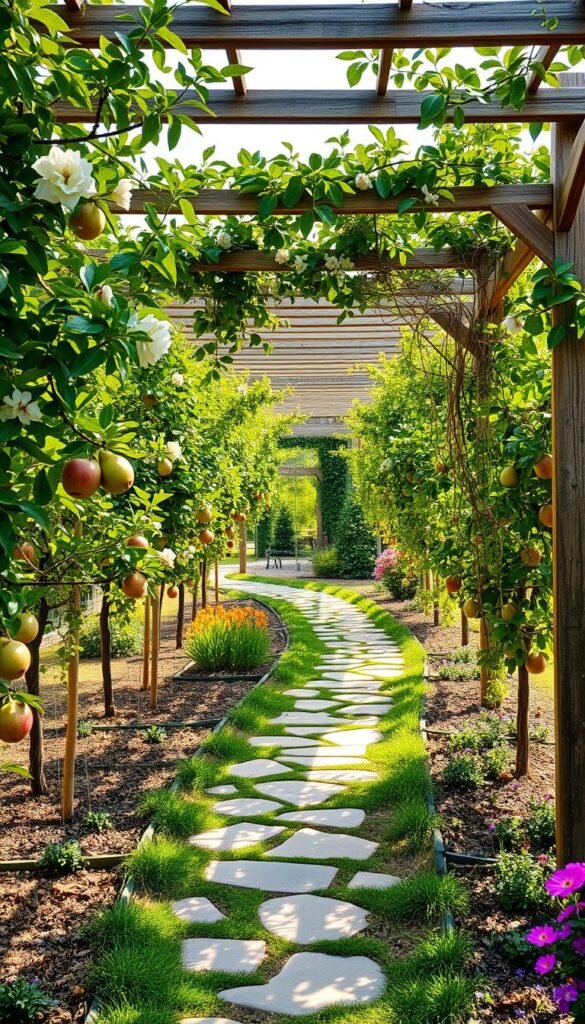Transforming your yard into a lively, eco-friendly space starts with smart choices. Adding edible trees and carefully selected greenery can turn even small areas into vibrant hubs. Imagine stepping outside to pick fresh snacks while enjoying nature’s beauty right at home.
Thoughtful planning ensures every inch works for you. Strategic layouts blend functionality with visual charm, making maintenance easier while boosting harvests. For example, curved walkways guide visitors through the space, while vertical structures help climbing varieties thrive without crowding.
Beyond aesthetics, these choices benefit your wallet and local ecosystem. Homegrown treats cut grocery bills and reduce reliance on store-bought produce. Plus, flowering varieties attract pollinators, creating a balanced environment where everything grows stronger together.
Whether you’re starting with pots on a patio or redesigning acres, this guide simplifies the process. You’ll learn to pair species that support each other, use structures wisely, and create a space that feeds both your family and local wildlife.
Understanding Your Fruit Garden Vision
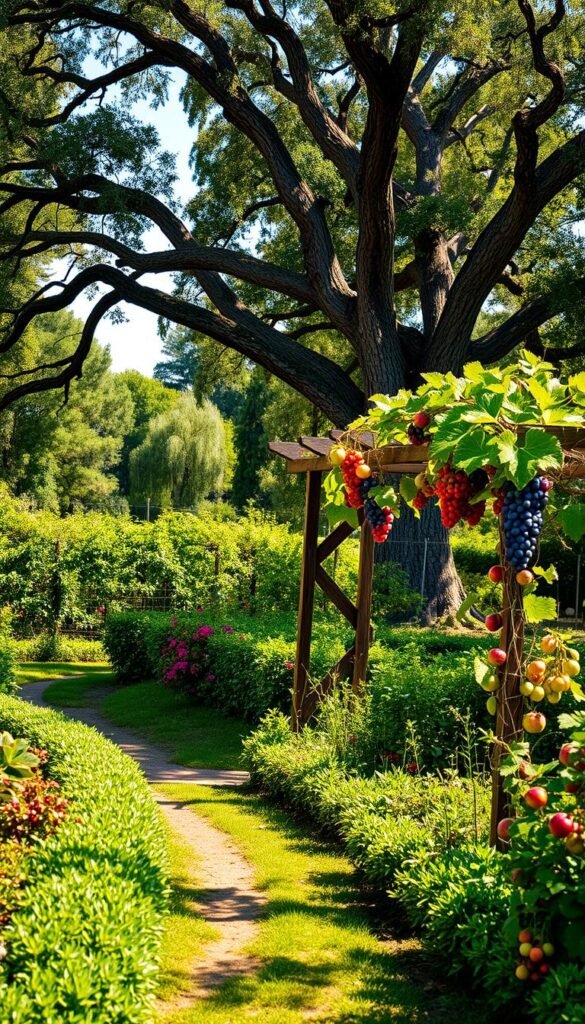
Crafting a thriving edible landscape begins with clarity. What do you want to achieve? A bountiful harvest, a peaceful retreat, or a mix of both? Your goals shape every decision, from plant selection to layout choices.
Defining Your Garden Goals
Start by asking: “What matters most?” If fresh snacks are your priority, focus on high-yield fruit trees like dwarf apples or citrus. For visual appeal, mix flowering shrubs with ornamental edibles. Remember, smaller spaces thrive with compact varieties that won’t overwhelm your yard.
Identifying Key Aesthetic and Functional Elements
Balance beauty and practicality. Choose colors that pop in autumn or spring—think cherry blossoms or persimmon leaves. Ensure pathways allow easy access for pruning and picking. If space is tight, explore vertical structures like trellises to save ground area while adding height.
Local climate plays a huge role. Citrus thrives in warm zones, while stone fruits need chill hours. Test your soil’s pH and drainage—most fruit trees demand well-drained earth. Match plants to sunlight patterns for steady growth.
Fruit Garden Design: Arranging Paths, Trellises, and Companion Planting Essentials
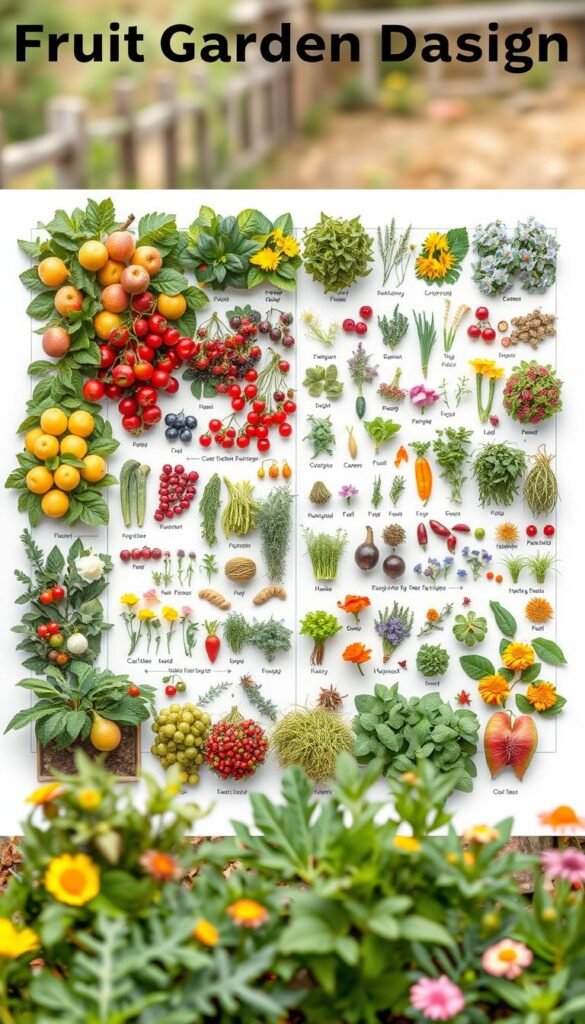
Smart layouts turn functional spaces into thriving ecosystems. Thoughtful placement of walkways and supports helps greenery flourish while keeping your space organized. Let’s explore how these elements work together.
The Role of Paths and Trellises in Garden Structure
Walkways do more than guide your steps. They prevent soil compaction around root zones, making trees healthier. Curved routes add intrigue while ensuring easy access for pruning.
Vertical supports save space and boost yields. Try training vines along arches or grids—they’ll catch sunlight without crowding nearby plants. This approach works wonders for grapes, berries, or climbing veggies.
Benefits of Companion Planting for Fruit Trees
Certain companion plants act as natural bodyguards. Basil repels flies near citrus, while marigolds deter nematodes. Garlic planted under apple trees reduces fungal issues naturally.
Include lavender or chives to attract beneficial insects like bees. These helpers pollinate blossoms and control aphid populations. You’ll notice fewer pests and richer soil over time.
This method cuts chemical use while adding color and fragrance. Imagine plucking peaches beside blooming nasturtiums—a feast for eyes and tastebuds!
Planning Your Garden Layout and Focal Points
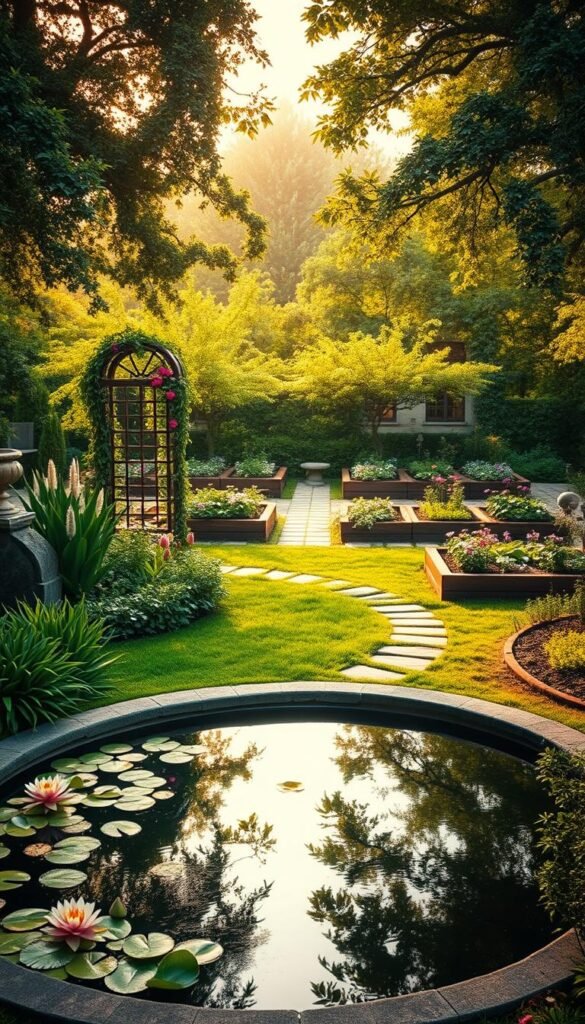
A well-organized layout transforms your space into both a functional and inviting retreat. Start by anchoring your design with a standout specimen. A mature apple or citrus tree works perfectly as a visual anchor, drawing the eye while offering shade and snacks.
Establishing Pathways and Borders
Walkways should curve naturally, wide enough for wheelbarrows but narrow enough to feel intimate. Line them with dwarf cherry or plum varieties—their compact size keeps fruit within reach while framing your “edible aisles”. This creates clean borders between growing zones without bulky fences.
Creating Visual Interest with Focal Points
Place your centerpiece tree where it gets full sun and room to spread. Surround it with lower-growing herbs or flowers that bloom in contrasting seasons. “A magnolia-esque pear tree becomes a spring showstopper, while persimmons glow amber in fall,” notes landscape designer Mara Klein.
Balance heights by mixing columnar apples with spreading figs. This layered approach adds depth and ensures year-round appeal. In tighter spaces, use potted citrus as movable accents—their glossy leaves and fragrant blossoms work double duty.
Keep pathways 3-4 feet wide for easy navigation. For larger yards, add secondary focal points like a berry arbor or stone bench under a mature tree. Just avoid clustering too many eye-catchers—let each element breathe.
Implementing Effective Companion Planting Strategies
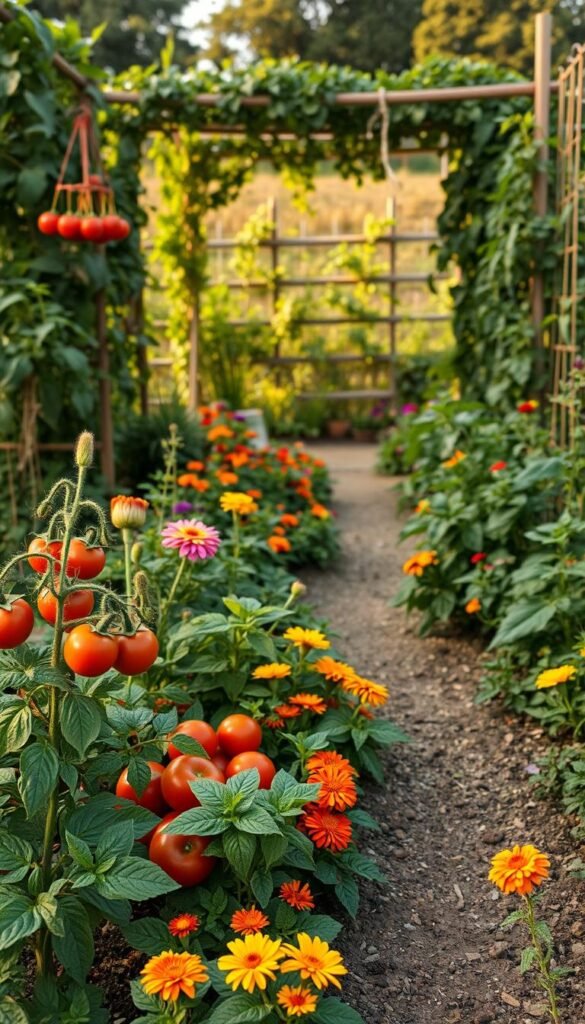
Boost your harvests naturally by pairing plants that work as a team. These partnerships improve soil health, deter pests, and create vibrant ecosystems. Let’s explore how to match species for maximum benefits.
Selecting the Best Companion Plants
Start with heavy hitters like marigolds and basil. Their strong scents confuse pests while attracting pollinators. Try this pairing near stone fruits or berries for natural protection.
| Companion Plant | Benefits | Best Paired With |
|---|---|---|
| Chives | Deters apple scab | Apple trees |
| Nasturtiums | Traps aphids | Citrus trees |
| Beans | Adds nitrogen | Corn |
Integrating Edible and Pest-Resistant Varieties
Garlic planted around peach trees fights borers while seasoning your meals. Flowering basils serve double duty—their purple spikes beautify spaces as they repel flies.
Designing a Fruit Tree Guild in Small Gardens
Create mini-ecosystems under dwarf trees. Layer comfrey for mulch, oregano for ground cover, and dandelions for deep soil aeration. This trio works wonders in tight spaces.
Space-saving tip: Train vining plants like beans up corn stalks. You’ll save room while getting two crops from one spot. Perfect for patios or balcony setups!
Integrating Trellises and Support Structures
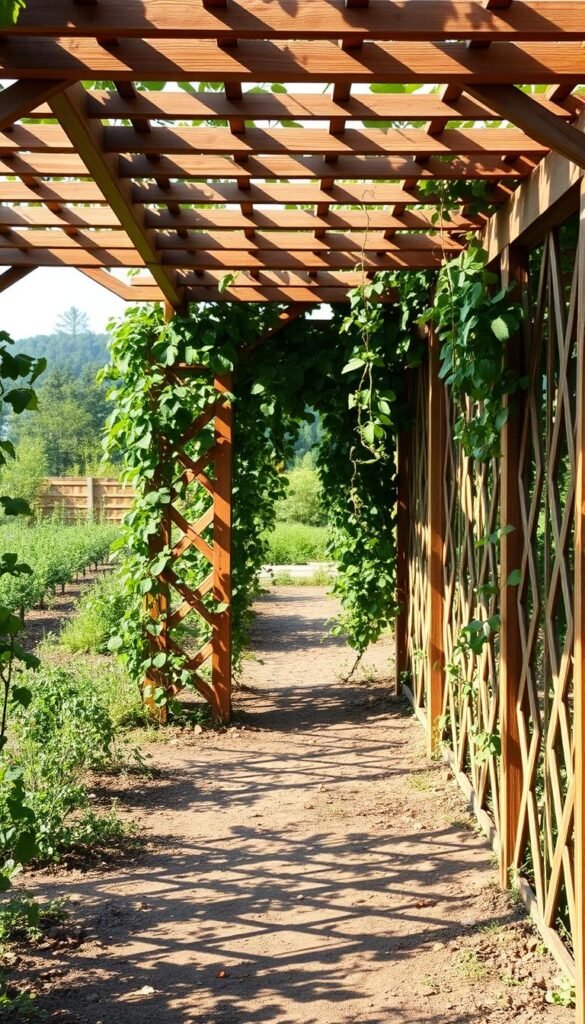
Elevate your edible landscape with smart structural support. The right framework keeps trees healthy while adding artistic flair. Let’s explore how to match materials to your green goals.
Choosing the Right Trellis for Your Trees
Dwarf varieties like columnar apples thrive with slatted wood systems. These offer stability without overwhelming their 10-12 ft height. For sprawling figs or peaches, metal grids handle heavier growth.
Remember: “A $50 tree deserves a $500 hole.” Dig wide, shallow pits to let roots spread. Leave 3-4 ft around each plant for future harvesting access. This prevents crowding as branches mature.
Setting Up for Visual and Structural Balance
Position supports where they’ll frame views, not block them. Angle arches to guide eyes toward blooming plants. Use weathered cedar or black powder-coated steel to blend with your style.
Young trees in windy zones need temporary stakes. Secure them with flexible ties—rigid bindings restrict natural movement. Remove supports after 18-24 months when trunks strengthen.
Plan for shade patterns as canopies expand. A pear tree planted south of seating areas creates cool summer retreats. Adjustable trellises grow with your plants, adapting to changing needs.
Maintenance, Pest Management, and Growth Techniques
Nurturing your green oasis requires more than just planting—it’s about smart care that evolves with each season. Consistent attention to growth patterns and seasonal shifts keeps your space thriving while tackling challenges before they escalate.
Watering, Pruning, and Fertilization Best Practices
Young saplings need deep, slow watering to strengthen their root systems. Aim for weekly sessions during dry spells, focusing on moisture penetration rather than surface sprinkles. Pair this with balanced nutrients—apply fertilizer in early spring as buds form, then again in late summer for sustained vitality.
Prune strategically during dormancy to shape future growth. Remove crossed branches first to improve airflow and light exposure. Always cut above outward-facing buds to direct new shoots away from the trunk.
Organic Pest and Disease Control Tips
Combat pests naturally by inviting their predators. Ladybugs feast on aphids, while birds handle caterpillars. Plant marigolds near vulnerable species—their roots emit compounds that repel harmful nematodes.
For stubborn infestations, spray neem oil mixed with castile soap directly on leaves. This duo smothers soft-bodied insects without harming pollinators. Discover more companion planting strategies to boost your defenses naturally.
Choose disease-resistant varieties when possible, and always clear fallen debris to disrupt pest life cycles. A little prevention saves time and preserves your harvest’s quality.

